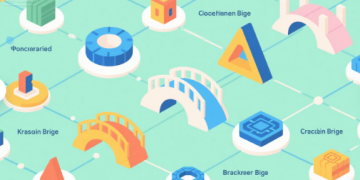In an era where blockchain ecosystems are proliferating—from Ethereum and Solana to Cosmos and application-specific blockchains—the need for seamless asset and data transfer across networks has never been more critical. Enter cross-chain bridges , the decentralized infrastructure that connects these isolated blockchains, enabling liquidity, innovation, and user flexibility. As the backbone of blockchain interoperability, cross-chain bridges are reshaping the Web3 landscape, and Bitora is your go-to source for navigating this transformative technology.
What Is a Cross-Chain Bridge?
A cross-chain bridge is a decentralized application (dApp) that facilitates the transfer of assets, data, and even smart contract interactions between distinct blockchains . Imagine blockchains as separate continents: one rich in natural resources (e.g., Ethereum’s DeFi ecosystem), another with fertile land (e.g., Solana’s high-speed transactions), and a third with booming industries (e.g., Cosmos’ modular chains). Cross-chain bridges act as the ships and railways that connect these continents, allowing users to leverage each chain’s unique strengths without being confined to a single ecosystem.
These bridges operate through mechanisms like lock-and-mint, burn-and-mint, or lock-and-unlock . For example, when transferring Ethereum (ETH) to Solana, a user locks ETH in a smart contract on Ethereum, and wrapped ETH (wETH) is minted on Solana. The reverse process burns wETH to unlock ETH. Advanced bridges like DeBridge even use intent-based models, allowing instant transfers and complex cross-chain actions like governance voting or NFT minting .

Types of Cross-Chain Bridges
Cross-chain bridges can be categorized based on their design and trust assumptions:
- Centralized Bridges: Operated by a single entity (e.g., Binance Bridge), these are fast but expose users to counterparty risk.
- Decentralized Bridges: Rely on multi-signature wallets or decentralized validator sets (e.g., Wormhole, DeBridge) to reduce trust in centralized parties .
- Hash-Locked Bridges: Use timelocked smart contracts (e.g., Lightning Network) for atomic swaps, ideal for peer-to-peer transactions.
- Sidechains: Enable bidirectional asset transfers (e.g., Polygon), but require trust in the sidechain’s security model.
- Atomic Swaps: Allow direct token swaps without intermediaries, though limited to specific chains .
The Critical Role of Cross-Chain Bridges in 2025
The blockchain interoperability market is projected to grow from $0.7 billion in 2024 to $0.91 billion in 2025, with a compound annual growth rate (CAGR) of 29.7% . This surge is driven by:
- DeFi Expansion: Users demand access to liquidity across chains. Bridges like Across Protocol enable near-instant ETH transfers between Ethereum layer-2 networks with fees under $1 .
- NFT and Gaming: Cross-chain NFTs (e.g., Bored Ape Yacht Club on Ethereum and Solana) rely on bridges for seamless asset movement.
- Enterprise Adoption: Supply chains and cross-border payments benefit from interoperable blockchains.
However, bridges remain a prime target for hackers. In 2024 alone, $2.83 billion was lost to bridge exploits, including the Orbit Chain hack ($82 million) and Wormhole’s $320 million breach . These incidents highlight the need for robust security measures like decentralized validation, zero-knowledge proofs, and AI-powered risk analysis .
Innovations Reshaping Cross-Chain Bridges
To address scalability and security, 2025 is witnessing groundbreaking advancements:
- Intent-Based Protocols: Solutions like DeBridge and Across Protocol use off-chain intents to execute cross-chain actions, reducing on-chain congestion and improving speed .
- Universal Interoperability: Projects like Chainlink CCIP and LayerZero aim to standardize cross-chain messaging, enabling developers to build multi-chain dApps with minimal effort .
- Enhanced Security: Bridges now adopt multi-party computation (MPC) and threshold signature schemes (TSS) to protect private keys. For example, Carrier uses multi-signature wallets to secure asset transfers .
- User-Friendly Interfaces: Aggregators like Rango Exchange simplify cross-chain swaps by routing transactions across 70+ chains, eliminating the need for users to navigate complex bridges manually .
The Future of Cross-Chain Bridges: Beyond Asset Transfers
As Web3 evolves, cross-chain bridges are expanding beyond token swaps to enable:
- Arbitrary Data Messaging: Bridges like Chainlink CCIP allow smart contracts to send data (e.g., oracles, governance votes) across chains, unlocking use cases like cross-chain DAOs .
- Quantum Resistance: With quantum computing threats looming, bridges are integrating post-quantum cryptography to future-proof security .
- Interoperable Layer-2s: Bridges like Arbitrum Bridge connect Ethereum’s mainnet to layer-2 solutions, reducing gas fees while maintaining security .
Bitora: Your Guide to Cross-Chain Success
In this rapidly evolving landscape, Bitora is your trusted partner for staying ahead. Our platform provides real-time insights into cross-chain trends, security alerts, and bridge comparisons, empowering users to make informed decisions. Whether you’re a developer building multi-chain dApps or an investor exploring DeFi opportunities, Bitora equips you with the tools to navigate the cross-chain frontier confidently.
As the blockchain ecosystem becomes increasingly interconnected, cross-chain bridges are no longer a luxury—they’re a necessity. With Bitora by your side, you’ll never miss a beat in the journey toward a seamless, interoperable Web3.
Stay ahead of the curve with Bitora’s cross-chain analytics. Visit Bitora today.


























